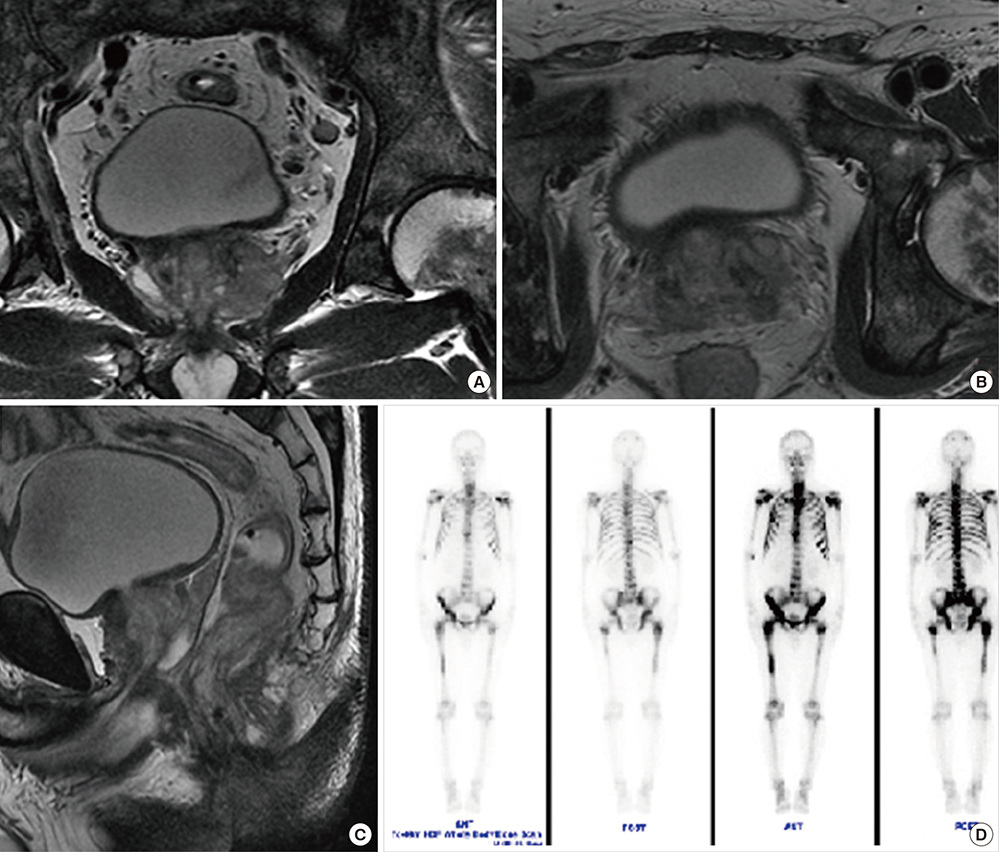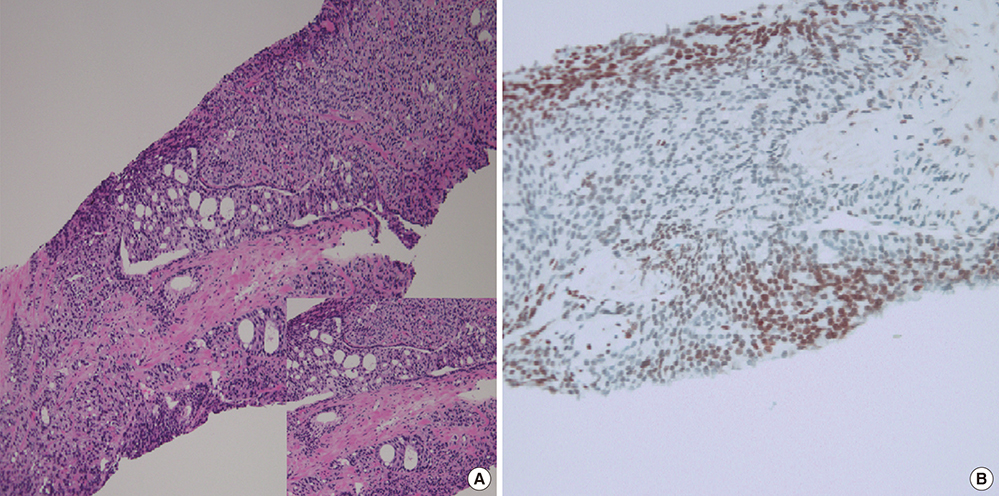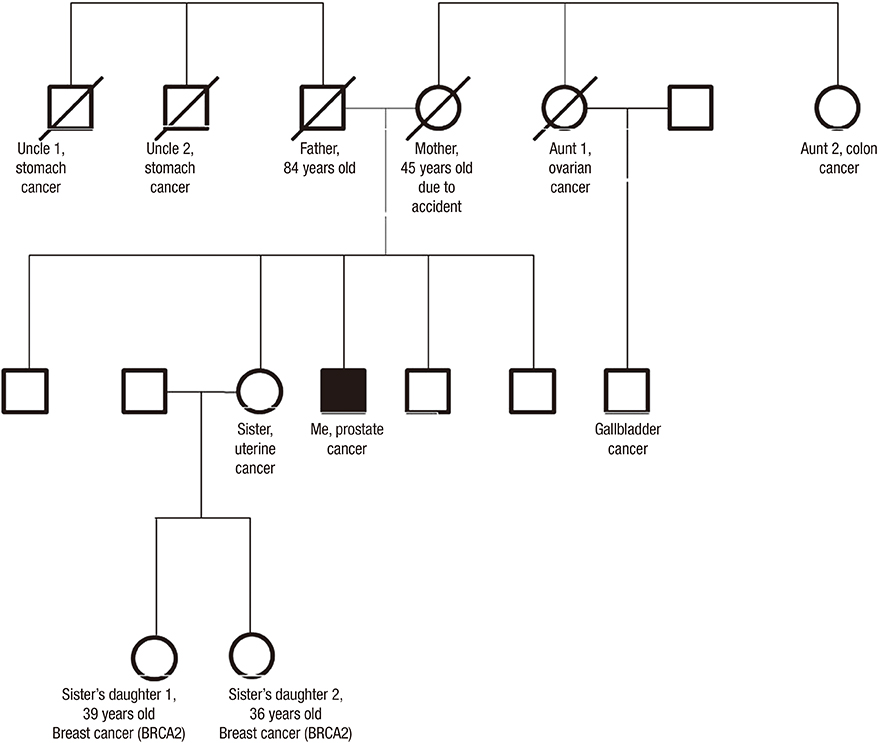J Korean Med Sci.
2017 Feb;32(2):377-381. 10.3346/jkms.2017.32.2.377.
Prostate Cancer in a Patient with a Family History of BRCA Mutation: a Case Report and Literature Review
- Affiliations
-
- 1Department of Urology, Seoul National University Hospital, Seoul, Korea.
- 2Department of Urology, Center for Prostate Cancer, National Cancer Center, Goyang, Korea. uroonco@ncc.re.kr
- 3Department of Pathology, Center for Prostate Cancer, National Cancer Center, Goyang, Korea.
- KMID: 2364186
- DOI: http://doi.org/10.3346/jkms.2017.32.2.377
Abstract
- One of the most significant risk factors for prostate cancer (PC) is a family history of the disease, with germ-line mutations in the breast cancer predisposition gene (BRCA) 2 conferring the highest risk. We here report a 56-year-old man presented with painful gait disturbance and diagnosed PC with multiple disseminated bone metastases. The patient had a strong family history of breast cancer with his 2 nieces affected. Furthermore, his aunts and uncles from both sides were diagnosed with stomach, ovarian, and colorectal cancers. His genomic sequencing analysis of the BRCA genes revealed the same BRCA2 deleterious mutation that his breast cancer-affected nieces carried. Previous studies have suggested that BRCA2-mutated PC is associated with a more aggressive phenotype and poor prognosis. Our experience in the present case also indicated the urgent needs for novel treatment modality and PC screening in this high-risk group of patients.
Keyword
MeSH Terms
Figure
Reference
-
1. Breast Cancer Linkage Consortium. Cancer risks in BRCA2 mutation carriers. J Natl Cancer Inst. 1999; 91:1310–1316.2. Venkitaraman AR. Cancer susceptibility and the functions of BRCA1 and BRCA2. Cell. 2002; 108:171–182.3. Moro L, Arbini AA, Marra E, Greco M. Mitochondrial DNA depletion reduces PARP-1 levels and promotes progression of the neoplastic phenotype in prostate carcinoma. Cell Oncol. 2008; 30:307–322.4. Castro E, Eeles R. The role of BRCA1 and BRCA2 in prostate cancer. Asian J Androl. 2012; 14:409–414.5. Eeles RA, Kote-Jarai Z, Al Olama AA, Giles GG, Guy M, Severi G, Muir K, Hopper JL, Henderson BE, Haiman CA, et al. Identification of seven new prostate cancer susceptibility loci through a genome-wide association study. Nat Genet. 2009; 41:1116–1121.6. Witte JS. Prostate cancer genomics: towards a new understanding. Nat Rev Genet. 2009; 10:77–82.7. Dite GS, Whittemore AS, Knight JA, John EM, Milne RL, Andrulis IL, Southey MC, McCredie MR, Giles GG, Miron A, et al. Increased cancer risks for relatives of very early-onset breast cancer cases with and without BRCA1 and BRCA2 mutations. Br J Cancer. 2010; 103:1103–1108.8. Audeh MW, Carmichael J, Penson RT, Friedlander M, Powell B, Bell-McGuinn KM, Scott C, Weitzel JN, Oaknin A, Loman N, et al. Oral poly (ADP-ribose) polymerase inhibitor olaparib in patients with BRCA1 or BRCA2 mutations and recurrent ovarian cancer: a proof-of-concept trial. Lancet. 2010; 376:245–251.9. Tutt A, Robson M, Garber JE, Domchek SM, Audeh MW, Weitzel JN, Friedlander M, Arun B, Loman N, Schmutzler RK, et al. Oral poly (ADP-ribose) polymerase inhibitor olaparib in patients with BRCA1 or BRCA2 mutations and advanced breast cancer: a proof-of-concept trial. Lancet. 2010; 376:235–244.10. Gallagher DJ, Cronin AM, Milowsky MI, Morris MJ, Bhatia J, Scardino PT, Eastham JA, Offit K, Robson ME. Germline BRCA mutation does not prevent response to taxane-based therapy for the treatment of castration-resistant prostate cancer. BJU Int. 2012; 109:713–719.
- Full Text Links
- Actions
-
Cited
- CITED
-
- Close
- Share
- Similar articles
-
- The Important Role of Poly ADP-Ribose Polymerase Inhibitor in Prostate Cancer
- Colorectal cancer with a germline BRCA1 variant inherited paternally: a case report
- Experience with Bilateral Risk-Reducing Mastectomy for an Unaffected BRCA Mutation Carrier
- Occurrence of contralateral breast cancer in a BRCA-positive breast cancer patient who underwent free TRAM flap reconstruction: a case report
- The association of family history of prostate cancer with the diagnosis of clinically significant prostate cancer in Korean population




